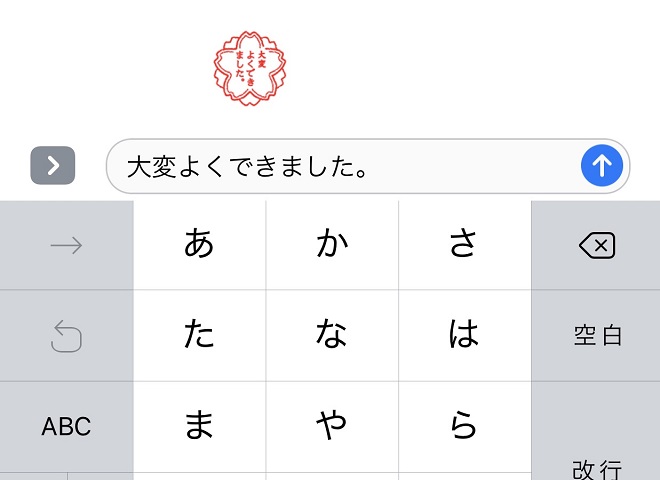How many of you have seen that red flower-stamp emoji in your phone and wondered what it meant? It actually says “taihen yoku dekimashita” in Japanese, written the traditional way starting from the top right and going straight down.
I’ll break it down word by word and go over each part so that when you are finished you will know the taihen yoku dekimashita meaning in Japanese and you’ll be able to use it yourself.
What Does TAIHEN Mean in Japanese?
The first part of the stamp is the word 大変 (taihen), which is written with the kanji for “big” and also the kanji for “change.”
It usually gets used as a more formal version of the word とても (totemo) which means “very.” Let’s say that you missed a call from an important customer, you might start off the conversation when you contact them with:
- 先ほどは大変失礼致しました。
saki hodo wa taihen shitsurei shimashita.
I’m very sorry about earlier.
Something about the word 大変 is that even though it means “very” in English, the word usually brings with it a negative connotation. Referring to the example sentence above, it would probably make more sense to interpret it as “terribly” rather than “very.”
- 大変疲れた。
taihen tsukareta.
I’m dead tired.
The other thing is that it can be used by itself to say that something is “tough” or “difficult.”
- 英語学習は大変ですね。
eigo gakushuu wa taihen desu ne.
Learning English is tough, isn’t it?
YOKU DEKIMASHITA Meaning in Japanese
The second and third words get used together a lot without 大変 added on.
The first word (yoku) gets written in both kanji and kana a lot as either 良く or よく and it’s an adverb that means “nicely, good, or well” in English.
- この薬を飲めばよくなるでしょう。
kono kusuri o nomeba yoku naru deshou.
This medicine will do you good.
The word よく can also means “often” in certain contexts.
As for the second word (dekimashita) it also gets written in both its kanji form and its hiragana form a lot. They are 出来ました and できました respectively.
In that red stamp emoji, both よく and できました are both written in hiragana, which I think is more common.
The word できました is the past tense form of the word できる (dekiru) which means “to be able to do” or how we would use the word “can” as in “I can do it.”
One of the easy ways to say you can do something in Japanese is to take a verb in its simplest form and add ことができます (koto ga dekimasu).
- 食べることができます。
taberu koto ga dekimasu.
I can eat.
- 飲む事が出来ます。
nomu koto ga dekimasu.
I can drink.
But getting back to the topic at hand, the phrase よくできました (yoku dekimashita) actually means “well done” and is told to someone after they’ve done a good job at some task. It might even be what your tutor tells you after you’ve finished your Japanese lesson for the day.
The Meaning of the Stamp
So now you can interpret the red stamp’s meaning.
大変よくできました (taihen yoku dekimashita) means “you did very well” on your task. ![]()
This is actually a real stamp that gets used by teachers in Japan when grading student’s work. Of course, it would only be used on the ones that the teacher considered high quality. Something like an A or A+ on the grade could get a stamp.
I hear that the emoji on the phone gets sent to people with kind of a sarcastic tone.
I don’t know as I’ve never really sent it or received it during any of my text conversations.
Well, hope you guys enjoyed learning about the stamp emoji – I’d love to hear from you with a comment!
Further Resources for Learning Japanese:
#3 Get My eBook (Secrets to Learning Japanese) for Free

またね!

Wow, I learned some Japanese from just reading your website. Japanese is an extremely hard language to learn, but you made it look easy! I think it’s great that you connected all of the Japanese games when you were a kid to now creating a great informative website about the language! Awesome!
Yeah, the sounds of the language are fairly easy, but the grammar and the use of omitting certain things makes it pretty hard for people who’s native language is English.
I actually wrote a little about how long it takes most people to learn Japanese in this post according to The Foreign Service Institute.
It’s not good, lol!